
New species: Ziegler’s crocodile newt (Tylototriton ziegleri). Photo courtesy of Tao Thien Nguyen.
Researchers have discovered a new species of Vietnamese salamander that looks like it was birthed from an abyssal volcano. Found tucked away in Tokyo’s National Museum of Nature and Science, the scientists described the species in the new edition of Current Herpetology. Coal-black with orange-tinted toes, the new crocodile newt (in the genus Tylototriton) was determined to be a new species when it showed morphological and genetic differences from near relatives. Despite its remarkable appearance, the researchers say these are typical colors for crocodile newts.
“I was asked by a curator to identify [the new species] and temporarily identified it as Tylototriton vietnamensis (the Vietnamese crocodile newt). However, the morphology was different from the original description of the Vietnamese crocodile newt,” Kanto Nishikawa with Kyoto University told mongabay.com. “Because I have never seen the Vietnamese crocodile newt I could not confirm the specimens in Tokyo are undescribed species. In 2012, I had a chance to visit Vietnam and discussed [the specimen] with co-author, Tao Thien Nguyen, and made a conclusion on its taxonomic status, as new species.”
The scientists named the new species Ziegler’s crocodile newt (Tylototriton ziegleri) after Thomas Ziegler of Cologne Zoo who works with reptiles and amphibians in Vietnam. The new species is small, with males measuring 5.4 to 6.8 (2 to 2.6 inches) centimeters and females measuring 7.1 centimeters (2.7 inches). While genetic testing proved that it was a new species, the morphological differences were key.
Ziegler’s crocodile newt is currently only known from only a small habitat of montane forest and wetlands.
“Currently, habitat loss and degradation, especially around the breeding ponds, is a major threat to the populations of the new species,” the researchers write in the paper. “Legal protection of their habitats and regulation of excessive commercial collection are important measures for conservation of this species.”
Crocodile newts are popular in the illegal pet trade and are often over-collected from the wild. There are now ten known species, eight of which have been evaluated by the IUCN Red List. Of these eight, three are threatened with extinction, four are listed as Near Threatened, and only one is Least Concern.
In the salamander family, newts have rougher skin than other salamanders as adults. Most of the world’s salamanders are in the newt family, also known as efts.

The larva of Ziegler’s crocodile newt. Photo courtesy of Tao Thien Nguyen.

Detail of adult Ziegler’s crocodile newt. Photo courtesy of Tao Thien Nguyen.
CITATION: Kanto Nishikawa, Masafumi Matsui, and Tao Thien Nguyen. A New Species of Tylototriton from Northern Vietnam
(Amphibia: Urodela: Salamandridae). Current Herpetology 32(1): 34–49, February 2013.
|
Photos: the top new species discoveries in 2012 (12/26/2012) Thousands of species were described for the first time by scientists in 2012. Some of these were ‘cryptic species’ that were identified after genetic analysis distinguished them from closely related species, while others were totally novel. Either way, here are some of the “new species” highlights from 2012. |
Related articles
Scientists clone extinct frog that births young from its mouth
(03/18/2013) Australian scientists have produced cloned embryos of an extinct species of frog known for its strange reproductive behavior, reports the University of New South Wales.
Captive frogs may be spreading diseases to wild cousins across Southeast Asia
(03/07/2013) Scientists have documented a series of links between exotic frogs for trade and diseases in wild frogs in Southeast Asia, including the first documented case of the chytrid fungus—a virulent and lethal disease—in Singapore. According to researchers writing in a new study in EcoHealth, frogs imported into Southeast Asia as pets, food, or traditional medicine are very likely spreading diseases to wild populations.
Starry frog rediscovered after thought extinct for 160 years (photos)

(03/07/2013) In 1853 Edward Frederick Kelaart, a physician and naturalist, collected a strange frog on the island of Sri Lanka then a British colony known as Ceylon. The specimen was a large shrub frog (about 2 inches or 5.5 centimeters long) with black-outlined white specks on lime-green skin. He dubbed it “starry” after its pale specks, but that was last anyone heard of it. Even the holotype—the body of the amphibian collected by Kelaart—went missing. Fast forward nearly 160 years—two world wars, Sri Lanka’s independence, and a man on the moon—when a recent expedition into Sri Lanka’s Peak Wilderness rediscovered a beguiling frog with pinkish specks.
Frogs radio-tracked for first time in Madagascar
![]()
(03/01/2013) Researchers have radio-tracked frogs for the first time in Madagascar. Attaching tiny radio transmitters weighing 0.3-0.35 grams (1/100 of an ounce) to 36 rainbow frogs (Scaphiophryne gottlebei), the research team tracked the movement of the colorful frogs through rugged canyons in Madagascar’s Isalo Massif. They found that the frogs have a short breeding period that occurs after the first intense rainfall at the start of the rainy season.
Two new species of mini-salamander discovered in Colombia
(02/28/2013) Biologists have discovered two new species of salamander in Tamá National Natural Park in Colombia. While the discovery should be cause for celebration, the news was dampened by the fact that both species are already infected with the deadly fungal disease, known as Batrachochytrium dendrobatidis (Bd), which has wiped out amphibian populations worldwide. Both of the new salamanders belong to the genus Bolitoglossa, which are web-footed salamanders found in the tropical Americas.
15 percent of Guyana’s reptiles and amphibians found nowhere else
(02/21/2013) Fifteen percent of Guyana’s 324 known species of reptiles and amphibians are found nowhere else in the world, reports a comprehensive new assessment published in the journal Proceedings of the Biological Society of Washington.
Photos: the top new species discoveries in 2012

(12/26/2012) Thousands of species were described for the first time by scientists in 2012. Some of these were ‘cryptic species’ that were identified after genetic analysis distinguished them from closely related species, while others were totally novel. Either way, here are some of the “new species” highlights from 2012.